|
Getting your Trinity Audio player ready...
|
[Want even more content from FPM? Sign up for FPM+ to unlock exclusive series, virtual town-halls with our authors, and more—now for just $3.99/month. Click here to sign up.]
When I think about government-run schools, I am reminded of Margaret Thatcher’s famous quote, “The problem with socialism is that you eventually run out of other people’s money.”
While taxes are not necessarily socialist, they can be overbearing, nowhere more so than in education. In fact, the government excels at spending other people’s money on schooling. The U.S. (i.e., taxpayers) spent $1.2 trillion on K-16in 2022.
Of that astronomical amount, spending on higher education amounted to $226 billion, which often goes to schools that don’t need it. Researcher Jay Greene examined payments to Ivy League schools and found that the federal government provides enormous subsidies to these elite institutions, which are the wealthiest universities in the country. “The eight universities in the Ivy League receive $1.8 billion each year from taxpayers, despite the fact that these universities are sitting on $192 billion in endowment funds. If they need money for buildings and electricity, donors have already given them plenty. There is no need for taxpayers to give the richest universities $1.8 billion each year to cover the costs of buildings that their donors have already enabled them to maintain and update.”
There are about 4,000 for-profit colleges in the U.S., and they receive the great majority of federal tax dollars for higher education, with just 22 colleges in the country refusing any public funds.
But the swindle doesn’t stop there. The American Enterprise Institute’s Nat Malkus runs the think tank’s Student Debt Forgiveness Tracker, which identifies all student loan revenue from the U.S. Treasury that has been “forgone or forgivenduring the Trump and Biden presidencies.” The tracker’s total now sits at about $415 billion.
Just as egregious, it has been revealed that the U.S. Department of Education has spent over $1 billion on various diversity, equity, and inclusion (DEI) grants for K-12 schools and other recipients. A report, released on December 12 by the watchdog group Parents Defending Education explains that this spending has been ongoing since 2021. PDE researchers found 229 such grants across 42 states, plus Washington D.C., during this period.
Big city school districts are especially brazen when it comes to spending other people’s money. As researcher Marguerite Rozanotes, Chicago is particularly concerning. “The district’s current $300 million budget gap is set to triple next year, which isn’t surprising since enrollment dropped 10% over six years as the district added staff. Now, it won’t close schools, won’t reduce the workforce and is being told by the mayor to give in to union demands for big raises. How would the math work? The mayor wants the district to take out a short-term, high-interest loan. Oh, and the city and district still need to work out how to make this year’s pension payment.”
Chicago has also given new meaning to the term “ballooning costs,” having spent more than half a million dollars on balloon displays in the last five years. The school district has targeted the money for elaborate exhibits to mark occasions like back-to-school, graduation, and Black History Month. Lost in all the celebrating is that just 15% of Chicago’s 8th-grade students are proficient in math, and 21% are proficient in reading. Also, data show that 22 Chicago schools have zero students who can read at grade level, while 33 reported the same for math.
Oh well, when you have a steady supply of balloons, literacytakes a backseat.
Seattle isn’t far behind Chicago when it comes to wasteful spending. Per Roza: “Two years ago, leaders agreed to a costly labor agreement that they admitted would require major cuts. But then they didn’t make those cuts. Instead, leaders exhausted all reserves and are borrowing money they’ll have to pay back by 2026. What’s the plan for the $100 million budget deficit? None yet.”
Regarding taxpayer grifting, the San Francisco Unified School District is vying for a leadership position. Chad Aldeman, who writes about school finance, asks, “How does a school district go broke with $1.1 billion in revenues?
He responds, “When it spends $1.3 billion.”
SFUSD, which is losing students rapidly, has budgetary problems that revolve around paying for employee positions using one-time federal relief funds and will need to lay them off or find other revenues or savings.
Additionally, SFUSD has not adjusted student enrollment projections to account for continued declines, does not track monthly attendance data, and, as a result, overstates average daily attendance in projecting future revenues. Its budget office has inadequate control over its payroll system and problems tracking employee overtime costs.
Elsewhere in California. Dan Walters notes that in 2023,Oakland Unified became mired in a perpetual financial crisisand has “spent many years in receivership for its mismanagement. For years, Sacramento Unified, too, has flirted with insolvency by overspending its revenues.”
There are indeed ways to save taxpayer dollars. Closing under-enrolled schools is an option.
Michael Petrilli, president of the Thomas B. Fordham Institute, writes that America has too many school buildings, and some will need to close. He cites the post-Great Recession Baby Bustas a big factor and adds that some traditional public schools also “lost students to charter or private schools during the Covid crisis, and not all came back. And some urban systems lost families to the suburbs (or to more distant environs) as the rise of remote work made urban living less attractive.”
Marguerite Roza adds that school closures make intuitive sense. “Smaller districts with fewer kids need fewer schools. A district with 40,000 students operates many more school buildings than a district with 20,000, which in turn runs more than a district with 10,000. With widespread enrollment declines…many districts are now grappling with whether to close one or more schools.”
School choice is also an excellent way to save taxpayer dollars.Martin Lueken, director of the Fiscal Research and Education Center at EdChoice, explains that a recent analysis of 48 school-choice programs across 26 states through 2022 estimates that school-choice programs generated cumulative net fiscal benefits for taxpayers “worth between $19.4 billion and $45.6 billion. This translates to up to $7,800 a student. Put another way, for every dollar spent on these programs, taxpayers have saved between $1.70 and $2.64—a significant return on investment.”
The future is not rosy for public education. Nationally, enrollment projections published by the National Center for Education Statistics estimate that K-12 enrollments will drop by 2.7 million students between 2022 and 2031. If this comes to pass, in 2031, public schools will have lost almost 4 million students since 2019. California alone has lost 420,000 students since 2020 and is projected to lose another million by 2031.
Slowing revenue, rising costs, and lower student enrollment have combined to lead Moody’s Ratings to issue a negative outlook for K-12 traditional public schools in 2025. (Moody’s gave charter schools a stable outlook for 2025.) According to the forecast, districts will face challenges in reducing expenses as the public puts growing demands on the sector and because staffing levels have increased based on federal COVID-19 emergency aid.
As Vanya Cohen says, “When there’s a single thief, it’s robbery. When there are a thousand thieves, it’s taxation.”
And hitting up taxpayers to fund a profligate school system is particularly felonious.
* * *
Larry Sand, a retired 28-year classroom teacher, is the president of the non-profit California Teachers Empowerment Network – a non-partisan, non-political group dedicated to providing teachers and the general public with reliable and balanced information about professional affiliations and positions on educational issues. The views presented here are strictly his own.


The Internal Robbery Service armed and Dangerous Biden the Worst
Historically, financing wars was often the reason, or excuse, for taxes. Even that sometimes verges on theft, financing the self-aggrandizement of the King.
Look no further than Zelensky and Ukraine for thievery.
$62 MILLION for a new high school in Pawtucket, Rhode Island. This is a lower income community of this Blue state. I’d like to know why a high school has to cost this much???
Public schools have managed to shoot themselves in the foot! The education industry has pretty much destroyed our public schools. Unions dictate school policy, decide where the money goes, and sets standards for hiring. More “administrators” are hired than teachers. The federal department of education has hastened this more than anything else. When I started school in 1956 each state determined the standards. SOMEHOW they managed to work together to give the United States a high level of education–no matter where you lived! Being from a military family I got a fine education regardless of where my father was stationed. And for those who have never been in the military–diversity was natural. We all learned the same things, were taught the same ideals, And later most of us served our country. For the most part, I was career Army, my children also received a fine education except for one son that was never taught phonics. It was a couple of years later on of his teachers figured this out and immediately started a remedial program to teach him. My hat is off to that teacher! Our children are our contribution to this nation. Unless we educate them PROPERLY they will contribute little to it’s continuance. Of course this may very well be the intent of our education industry!